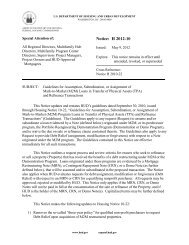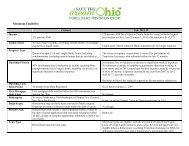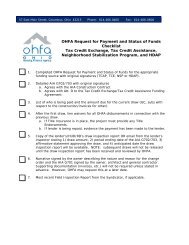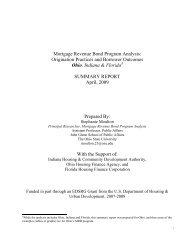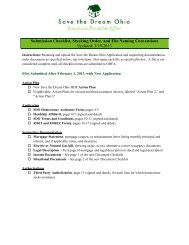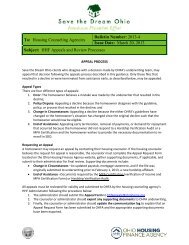lis 217 stemming the tide - LISC
lis 217 stemming the tide - LISC
lis 217 stemming the tide - LISC
- No tags were found...
Create successful ePaper yourself
Turn your PDF publications into a flip-book with our unique Google optimized e-Paper software.
pounded and accruing. In many cases <strong>the</strong>senotes will consume a substantial portion of <strong>the</strong>cash proceeds realized on sale, reducing <strong>the</strong>amount available to cover <strong>the</strong> seller's exit taxliability. The amount due may even exceed <strong>the</strong>residual equity value of <strong>the</strong> property.Transaction Impact. In cases with substantialsecondary debt, <strong>the</strong> note holder (though notusually present at <strong>the</strong> negotiating table) may be<strong>the</strong> party actually driving <strong>the</strong> conversion, sale,or refinancing transaction. The note holder maybe able to force a market-rate conversion to satisfy<strong>the</strong> value of <strong>the</strong> note, or block <strong>the</strong> transactionby threatening foreclosure. At same time,an owner whose equity is substantially wipedout by secondary financing obligations has littleincentive to move <strong>the</strong> transaction forward.Often transactions involving large amounts ofsecondary debt become paralyzed until <strong>the</strong>interests can be renegotiated.Public Note Holders. A public agency that holdssecondary debt on a subsidized property maybe in a position to help facilitate a preservationtransaction. For example, <strong>the</strong> public lender maybe willing to forego or defer repayment if <strong>the</strong>project continues as affordable housing, or torecycle <strong>the</strong> funds back into <strong>the</strong> deal for apreservation purchaser.Cash FlowCash flow—<strong>the</strong> bottom line—is an importantindicator of <strong>the</strong> overall health of <strong>the</strong> propertyand may provide clues to <strong>the</strong> owner's motivations.How has <strong>the</strong> property performed historically—i.e.,over <strong>the</strong> past three years? Has cashflow been distributed to investors? Has cashflow exceeded <strong>the</strong> applicable dividend restrictions,leading to <strong>the</strong> accumulation of ResidualReceipts? (See Regulatory.)Reserve BalancesThese highly regulated, sometimes large, cashaccounts can affect an owner's motivation toconvert or sell and can be an important factor inprice negotiations.Residual Receipts. What is <strong>the</strong> account balance,and who gets <strong>the</strong> funds if <strong>the</strong> property is refinancedand/or <strong>the</strong> subsidy contract terminates?(see Regulatory) If Residual Receipts in a subsidizedproperty are substantial and will belongto <strong>the</strong> owner, <strong>the</strong>re could be a high conversionrisk. If Residual Receipts are low or if <strong>the</strong>y willrevert to HUD or <strong>the</strong> HFA, <strong>the</strong>re is usually lessincentive to convert.Replacement Reserves. What is <strong>the</strong> account balance?These funds ultimately belong to <strong>the</strong>owner, so if <strong>the</strong>y are substantial, <strong>the</strong>re could bea higher conversion risk. If <strong>the</strong> property is sold,<strong>the</strong> buyer should probably expect to purchase<strong>the</strong> Replacement Reserves, unless <strong>the</strong> seller isunsophisticated or unusually cooperative.Operating CostsA good understanding of project operating costs(historical and projected) is necessary for estimating<strong>the</strong> value of <strong>the</strong> property, assessing <strong>the</strong>feasibility of a purchase, and anticipating futureoperating requirements.Historical. How much has it cost to operate <strong>the</strong>property over <strong>the</strong> past 3 years? How do <strong>the</strong>secosts compare with <strong>the</strong> expenses of similarproperties?Projected. How much will it cost to operate <strong>the</strong>property under new, preservation-oriented ownership?Which budget line-items can be trendedfrom actual operating experience? Which lineitemsare likely to change? For example:• Utilities should be adjusted for proposedenergy efficiency improvements and/or conversionof systems.• Maintenance costs should reflect any operatingefficiencies associated with proposed renovations,as well changes in on-site staffingand contracting arrangements due to newownership and management.• Taxes and insurance may need to be adjustedbased on <strong>the</strong> new purchase price.• Management fee may be different under anew management company.• Services like security or tenant services maybe increased, decreased, or provided differentlyunder new ownership.chapter four: Researching <strong>the</strong> Property: Towards a Preservation Strategy43



